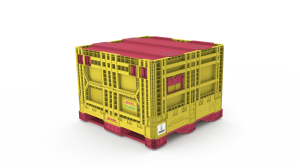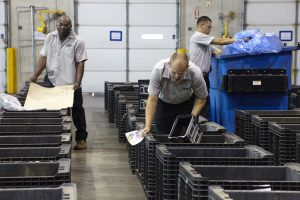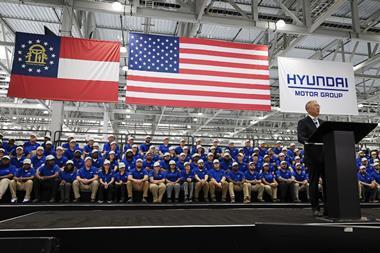 The conflicting demands of part protection, transport efficiency and line-side access often require innovative solutions from packaging designers
The conflicting demands of part protection, transport efficiency and line-side access often require innovative solutions from packaging designers
Carmakers and their suppliers increasingly recognise the importance of getting inbound packaging right, to boost quality by eliminating transit damage, save costs by allowing more components to be squeezed into a truck, and increase efficiency by easing access in production. Unfortunately for packaging designers, the ideal packaging solution for each of these requirements may be quite different. Add in the need to rein in costs, or the desire to reuse existing container fleets, and engineers face a tricky task.
For Patrick Clark, vice-president of industrial and automotive at Orbis Corporation, effective part protection comes “first and foremost” when designing a new solution. “If we manage to squeeze more parts into containers and trailers, but a percentage of them arrive scratched, then we have failed,” he reasons. Understanding the customer’s line-side needs is also critical, as some facilities have tight constraints on the size of the container that can be accommodated in production, or determining the orientation of parts within the container.
Once they understand those variables, Orbis’s engineers can look for ways to maximise the density of individual packs and of packs in each truck.
It is as they explore opportunities to boost efficiency by the final few percentage points that differences between customers begin to emerge, says Clark. “Some of our customers push for more density, while others push for protection,” he says.
“You need to understand the triggers for each customer and each specific part being packaged, and tune your designs accordingly.”
Jeff Cox, managing director of packaging design firm Ryobe UK, has plenty of experience understanding the varying demands of different supply chain players. “You often find that the end user wants maximum packaging density, while the supplier is more interested in protection,” he says. “You also need to consider the person putting the part into the package, and taking it out, and you can bet you really want a different orientation for loading and unloading.”
Twenty years ago, says Cox, packaging designers could find themselves caught in the middle of these conflicting demands. “The supplier and the OEM each said what they wanted, and you were left to find a solution,” he says. “Now it is much more common for people to get together earlier in the process to discuss their needs. That way you can explain the benefits and pitfalls of different options and get more harmony right from the start.”
Eric Schweers, senior engineering and process manager at packaging consultancy Surgere, says the starting point in automotive packaging is fitting to standard pallets, and working through constraints from there. The most cost-effective solution is usually bulk packaging of parts, says Schweers, but there are factors that can lead companies to adopt smaller container sizes.
“The assembler may have very limited line-side space, or there may be numerous variants of the part, which increases complexity at the line,” he says. Typical of the latter category are coloured or painted parts that must be matched to corresponding vehicles, he notes, adding that the trend to push more models and variants down the same production line is further increasing pressure on line-side space.
Material handling matters
Bridget Grewal, packaging continuous improvement manager at tier one supplier Magna, agrees that improving transport density is always a priority, noting that it is worth spending more on containers that offer improved utilisation. “Packaging is a one-time cost, while transportation is an on-going cost,” she says. The requirements of Magna’s customers place some constraints on its ability to maximise utilisation in its own outbound logistics, however. “Typically, we want to pack in bulk, but our customers want small amounts delivered to the line at any one time.”
It isn’t only line-side space constraints that encourage the use of smaller packaging, notes Grewal, material handling considerations matter too, with customers looking for containers that are easier to lift and handle. “Once we know how many components the customer wants at the line side, typically enough for one or two hours of production, we can look for the smallest container that can reasonably hold the required number of parts.”
For small, but delicate parts, Magna is exploring returnable dunnage solutions to drive up container utilisation. “We are prototyping glued, flexible dunnage that gives us the part-to-part separation we need, but which can also be shaped to fit the part contours so we can nest parts more effectively in a container,” she says. Replacing corrugated board cell packs with flexible dunnage can allow higher utilisation, “from 12 to 16 or 20 parts per container,” with the added advantage of a very small, collapsed size for the return journey.
Big, heavy parts come with their own challenges. “Usually, if a part weights more than 35lbs (15.75kg) and is loaded from the side, you need to design the packaging to accommodate a lift assist,” says Grewal. “And making room for that means you lose 18 inches (45.7cm) of usable space in the rack.”
For some categories of large parts, Grewal and her team are extending the nesting concepts that have proved effective at improving utilisation of smaller ones. “Fascia modules are C-shaped, yet the racks they ship in are rectangular,” she says. “We are developing a non-rectangular, tessellating shape that will allow us to almost double the number of fascias in a trailer.”
At the US operations of tier one supplier Mahle, the approach to inbound packaging design is evolving over time, says Martin Weiss, manager of corporate logistics. “In the past, our primary focus was to cube out the trucks,” he says. “Now we take a value stream approach to packaging design, with much more attention to better ergonomics and to limiting lot sizes and the number of parts at the line.”
Weiss’s, colleague, Chuck Hineman, the company’s transport and packaging concepts manager, is tasked with ensuring the right packaging and logistics decisions are implemented in inbound and outbound flows. “We’ve developed a packaging specifications manual which shows our preferred solution by commodity and by customer,” he explains. “And those specifications include details designed to maximise efficiency in production.”
An example of this is the use of ‘shoebox-style’ lids on cardboard packaging to save time when cartons are opened at the line. Mahle has also made significant investments in returnable packaging.
Repacking complexities
In some circumstances the best packaging for transport and line-side delivery are so different that OEMs prefer to introduce a repackaging step between bulk shipment from the supplier plant and delivery to the line. Such activities come with added costs, of course, with extra labour required to handle the parts, an extra packaging loop and another opportunity for quality problems to arise.
In its own inbound supply chains, says Weiss, Mahle tries to use single packaging from end to end wherever possible. “We think repackaging is a significant source of waste – you have double handling and have a loss of traceability.”
The delicate nature of some parts, like radiator components, makes them susceptible to handling damage, he notes, making double handling particularly undesirable. There are exceptions, like parts with a high number of variants – up to 400 in the case of some Mahle products – when the company does carry out pre-sequencing in order.

At Orbis, Patrick Clark notes an increase in the use of kitting approaches by its customers. Containers for kits, he says, are often complex packages, but because they are used on such short loops, they tend to be required only in comparatively small volumes.
The long run
Another driver of repackaging between supplier and assembly is the growth of long distance supply chains. As distances increase, it becomes harder to make the business case for returnable packaging, resulting in more disposable material. Besides the on-going cost of buying and recycling such packaging, concerns about contamination of parts with packaging fibres and fire risks make many companies reluctant to see disposable packaging inside their plants. “Some OEMs allow corrugated packaging at line side, but many don’t,” says Schweers. “[Therefore,] many companies ask their suppliers to repackage before final delivery.”
Others believe the benefits of a single package solution are leading to more disposable packaging in plants. At Ryobe, which designs both returnable and disposable solutions, Jeff Cox says it is “becoming more apparent that disposable is the right solution for long distances.”
James Haward, UK sales director for heavy-duty products at packaging maker DS Smith, says the material his company sells to the automotive industry is “90% single trip”, with a focus on long distance supply chains. For these customers, packing density is usually of primary importance, along with part protection, decanting speed and end-of-life recyclability. “If the benchmark for density is an existing returnable solution, we can almost always offer an improvement,” he says.
While the materials that DS Smith uses to meet these requirements are simple – primarily corrugated board and kraft paper – the secret is in careful design and specification. “Our engineers use CAD modelling and finite element analysis to validate designs, and we have invested in the development of the optimum board types for these requirements, and on other components, like high-wet-strength adhesives,” he says. “We also attach data loggers to real parts in transit to see the conditions they suffer.”

Share options
Returnable packaging isn’t giving up long distance supply chains without a fight, however. For ‘shorter’ long supply chains, folding containers and collapsible dunnage help reduce empty transport costs. At Magna, for example, Bridget Grewal is evaluating a new container design that promises to speed and simplify knockdown parts while boosting the return ratio by a third.
Mahle, meanwhile, is using returnable containers with expanded polypropylene foam dunnage on the 1,600-mile (2,560km) routes between its plants in Mexico and Dayton, Ohio. The shift from disposable packaging for these applications has “reduced a lot of damage” says Chuck Hineman. For longer routes, Weiss notes that more companies are entering the market with container sharing or pooling solutions, allowing manufacturers to take advantage of returnable containers while only needing to manage one half of the loop. “As more options become available, we expect to see an increase in the use of returnable packaging for overseas transport,” he says.
For example, Stewart Robertson, managing director of global packaging and strategic development for Europe, Middle East and Africa at DHL, says his company’s division exists specifically to meet the challenge of long distance supply chains. “We identified some time ago that long distance flows were increasing, but our customers were finding it hard to make returnable packaging work. They needed somebody to join the dots and unblock the imbalance in the flows.”
"We identified some time ago that long distance flows were increasing, but our customers were finding it hard to make returnable packaging work. They needed somebody to unblock the imbalance in the flows" - Stewart Robertson, DHL
DHL’s approach has been to target flows where it can identify synergies that allow it to reuse containers, and to focus on a single container type – the IsoBin 33 folding polypropylene container produced by Macro Plastics, which Robertson says, is “tougher, more durable, has more capacity and a better folded ratio,” than alternative high-density polyethylene products.
Robertson insists, however, that DHL’s packaging model considers all facets of part protection, transport and access. “There can be a tendency for packaging engineers to focus just on their own particular tasks, whereas you need to consider decisions right through the chain,” he says.
Among those decisions are ensuring that high cube shipping containers are specified on the relevant routes, and that the right handling equipment is installed at either end of the chain. “We typically find that the overall savings will more than pay for any investments in additional handling equipment.”
Ultimately, different parts, routes, philosophies and production processes will encourage the adoption of correspondingly different approaches. At Orbis, Patrick Clark notes that some carmakers are even changing the design of components themselves to eliminate tricky packaging challenges. However, smart packaging engineers aren’t likely to become disposable any time soon.

























![Global[1]](https://d3n5uof8vony13.cloudfront.net/Pictures/web/a/d/s/global1_726550.svgz)










